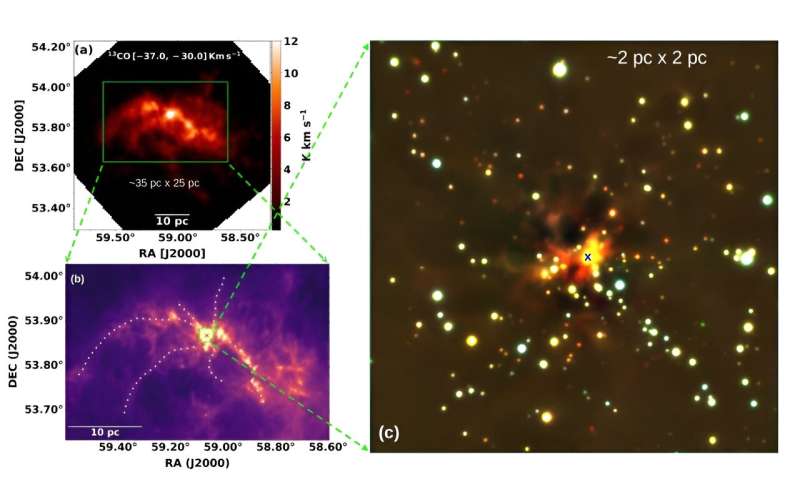
September 2, 2024 by Tomasz Nowakowski , Phys.org
Collected at: https://phys.org/news/2024-09-explore-nature-newborn-stellar-cluster.html
Researchers have conducted detailed infrared observations of a recently formed stellar cluster in a giant molecular cloud designated G148.24+00.41. Results of the observational campaign, presented in a research paper published August 23 on the pre-print server arXiv, deliver important insights into the nature of this newborn cluster.
Located some 11,000 light years away, G148.24+00.41 is a bound, massive and cold giant molecular cloud. It has a radius of about 84.7 light years, mass at a level of 100,000 solar masses, and its dust temperature was measured to be 14.5 K.
G148.24+00.41 has a hub-filamentary morphology and shows the signatures of global hierarchical collapse. In general, some giant molecular clouds showcase filament-converging configurations, fostering cluster formation at junction points known as hub-filament systems.
One such hub is located near the geometric center of G148.24+00.41 and represents its most massive clump—designated C1. Observations conducted in 2023 have found that a cluster formed in the central region of C1, known as the CC region. The cluster, which received the designation FSR 655, appears to be extremely young, as it is barely visible in optical images.
Now, a team of astronomers led by Vineet Rawat of Physical Research Laboratory (PRL) in Ahmedabad, India, has decided to take a closer look at FSR 655, aiming to shed more light on the properties of this recently discovered cluster.
“In this work, we conduct a deep NIR [near-infrared] analysis of the cluster, using the data obtained with the newly installed 3.6 m Devasthal Optical Telescope (DOT), complemented by catalogs from the Spitzer observations. We aim to improve the understanding of the current status of the cluster in terms of its evolutionary stage, mass distribution, star-formation efficiency and rate, and likely fate in the context of massive cluster formation,” the researchers explained.
The observations found that FSR 655 has a present-day total stellar mass of about 180 solar masses, while its gas mass is around 750 solar masses. The age of the cluster was estimated to be some 500,000 years.
Based on these results, the star formation efficiency (SFE) of FSR 655 was calculated to be at a level of 19%. When it comes to the cluster’s star formation rate (SFR), it was measured to be approximately 360 solar masses per one million years.
Therefore, the authors of the paper suppose that if the SFR continues at the current rate, FSR 655 has the potential to become a massive cluster in the future. They estimate that it could reach a total stellar mass of around 1,000 solar masses within two million years. However, further near-infrared observations, combined with detailed simulations of stellar and gas motions are necessary in order to confirm this.
More information: Vineet Rawat et al, Peering into the Heart of the Giant Molecular Cloud G148.24+00.41: A Deep Near-infrared View of the Newly Hatched Cluster FSR 655, arXiv (2024). DOI: 10.48550/arxiv.2408.12969
Journal information: arXiv

Leave a Reply